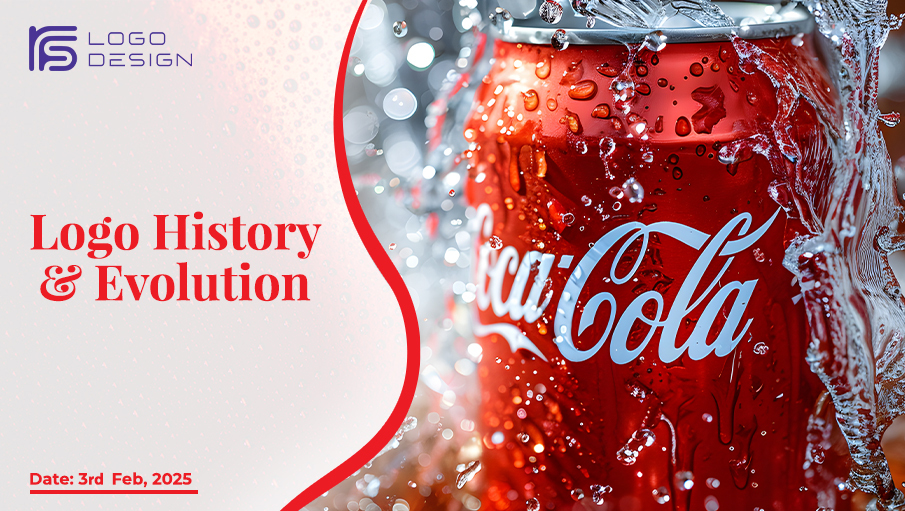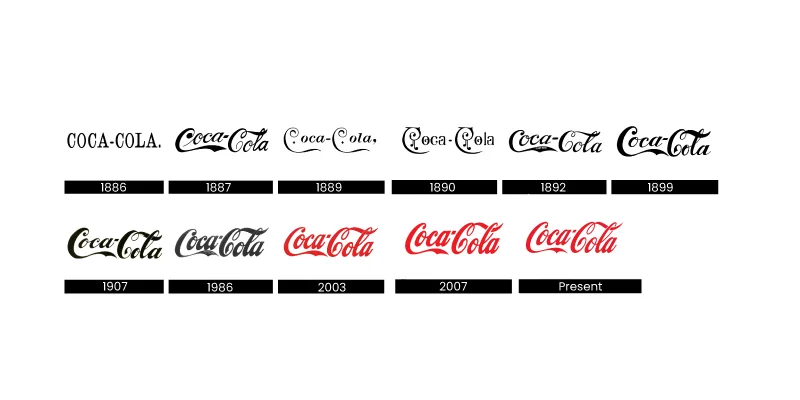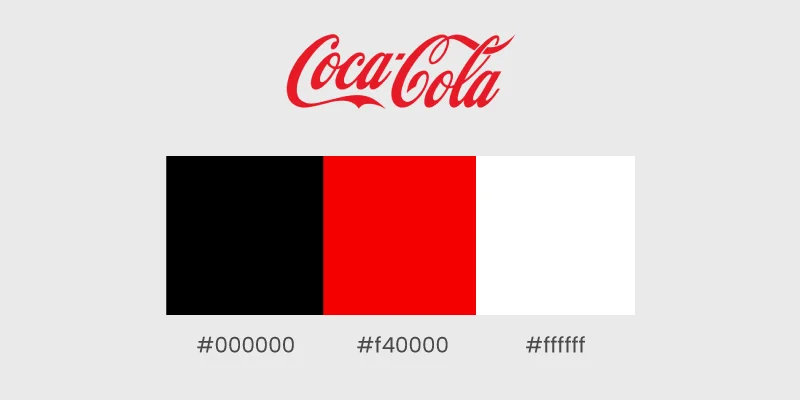
Coca-Cola Logo: History & Evolution
Category:
Tag(s):
Did you know? Coca-Cola has a history of nearly 140 years, from its evolution and adoption to changing consumer tastes, following new trends, and fulfilling global demands. Despite the changes in its soft drink tastes, this giant beverage company also has a history of changes in its logos. The Coca-Cola Company was established in the year 1886 by Dr. John Stith Pemberton, who was a pharmacist in Atlanta, Georgia, and the name of the company was suggested by Pemberton’s bookkeeper Frank M. Robinson, who also made the custom logo design of Coca-Cola.
Initially, Pemberton decided to make a medicinal syrup to cure headaches and fatigue, and it was also sold in the market as a syrup that can be mixed with carbonated water. The original formula included coca leaf extracts which contained some cocaine traces later removed in the year 1904 and sold out as medicinal syrup in different medical stores In Atlanta.
Coca-Cola’s Logo History
The Coca-Cola logo was first introduced in the year of 1886 by the bookkeeper of Pemberton and was made with Spencerian Script, a very popular handwriting style in the 19th century. The words were written in flowing, elegant letters. In the 1890s-1900s, a slightly modified version of the logo was introduced, featuring ornate swirls, but it didn’t go far, and in 1900 the original logo was returned back and established as the official logo. In the 1950s, the company opted for the red and white theme as its official brand colors. In the year 1958, they changed the logo, which looked like a fishtail, and after the 1960s, they returned back to their original logo of clean script. Later, in 1969, a dynamic ribbon (or white wave) was added to the logo.
The Evolution in Coca-Cola’s Logo-Modern Era

The Coca-Cola’s logo evolution has a great history from past many years and in present era also. The further changes to the logo happened in 2000s when a glass bottle logo was introduced in the year 2003 that emphasized on the Coca-Cola heritage, then in 2011, it is refined with a simple approach and kept the red-white script.
The Market Share of Coca-Cola in the USA Market
The beverage giant Coca-Cola maintains a dominant position in the soft drink market in the USA. In 2022 the company held a 43.3% share, which shows the company’s strength in the beverage industry of the USA. The other products of the company also helped to increase its share in the USA market, like Coca-Cola Classic, which holds a 19.2% share, followed by Diet Coke and Sprite, with 8.1% share, respectively, about half of the share in the soft drink industry of the USA held by these Coca-Cola brands.
Coca-Cola & Major Logo Design Services in the USA
As the time passed, the beverage giant has also collaborated with many US branding agencies to refine its image better. Coca-Cola has took the top logo design services in the USA like, Turner Duckworth, Interbrand, and Pentagram. These logo design agencies has also played campaigns like “Share a Coke” where custom name logo design were created.
USA Logo Design Firms Role in Coca-Cola’s Branding
Many USA design firms are specialized in hand-drawn lettering, maintaining the brand’s classic feel with small refinements. These designing firms also help Coca-Cola's logo for the betterment of its digital presence on social media. Many USA companies have implemented the same marketing strategies that Coca-Cola deploys, like consistency, emotional appeal, and timeless design. The branding of Coca-Cola has overshadowed all others when it comes to logo design and marketing in the US. These firms continue to examine Coca-Cola’s branding to find ideas for new company identity ventures.
Current Overview of the Coca-Cola Company
As of 2025, the current CEO of the company is James Quincy. He is a British businessman based in the USA. James joined the company in the year 1996 and was later named the CEO in 2017. Currently, more than 86,000 employees are working in this beverage giant worldwide, and the company’s portfolio includes a range of products, including carbonated beverages, energy drinks, and juices.
Coca-Cola’s Advertising and Marketing Strategies
Like a big company, its advertising or marketing is also extensive, their massive advertising campaigns come mostly on events like Christmas or global events like the Olympics, Cricket World Cup, and FIFA World Cup. They also have big celebrities in their campaigns, like Lionel Messi, and Hollywood or Bollywood actors, this shows how much this beverage giant spends on their advertising/marketing campaigns. Earlier in 2020, Cristiano Ronaldo removed the two Coca-Cola bottles in front of him during a press conference at Euro 2020. Because of this action, there was a negative impact on Coca-Cola sales, which dropped around $4 billion, and a share drop of 1.6% from $56.17 to $55.22. This is something gone negative in the advertising perspective for Coca-Cola for the first time in 100 years.
What is the Meaning of the Coca-Cola Logo?
A logo allows people to see a brand visually and it displays an organization's mission statement as well as its principles and it shows what products they provide. The Coca-Cola logo displays its offered product effectively through a representation of a black cold beverage.
Consumers across the world recognize Coca-Cola logo and all its related products with ease. Within the Coca-Cola logo viewers naturally experience four meaningful elements that convey tenderness along with zeal while showing purity together with humbleness. This branding technique shows reverence for both the visual strength of branding symbols along with corporate character even though it does not explicitly present the company's main items.
The Color Palette

The Coca-Cola logo began with black and white colors to create a sophisticated and formal appearance. The logo underwent another change when the manufacturers transformed it to red and white colors to represent energy, love, and a youthful appearance.
The company Coca-Cola adamantly refutes rumors that the familiar red shade within their advertising logo resembles Santa Claus. The Coca-Cola beverage giant states that since its first day, the distinctive red hue has functioned as a main part of its brand identity.
Over 140 years ago, Coca-Cola started distributing products by barrels within pharmacies in a way that resembled alcoholic beverage product distribution. The tax law separated alcoholic barrel payments from tax-free taxation of soft drinks. The company deliberately painted barrels red to prevent any attitudinal confusion. Coca-Cola chose red as its official brand symbol following the period during which cardboard barrels displayed red paint.
Global Reach of the Company
Coca-Cola, one of the most recognized soft drink brands in the world, is selling over 1.9 billion servings in a single day. This beverage giant is currently working in more than 200 countries and has a superior, distributed bottling network with over 275 independent bottling partners globally.
On the other hand, the sustainability goals of Coca-Cola include water preservation projects that seek to recover water usage in its products at levels above what the company consumes. All packaging used by Coca-Cola will become completely recyclable in 2025, and the company plans to boost the use of recycled materials within its bottles. Coca-Cola takes action to achieve carbon neutrality by using energy-efficient technologies together with renewable energy sources to reduce its carbon emissions.
Innovation and New Products
The Coca-Cola Company develops new product lines for market expansion through its launch of Coca-Cola Energy, which entered the energy drink market during 2019. The company has introduced Coca-Cola Plus and Coca-Cola with Coffee as their way to offer healthier beverage alternatives to their customer base. The touch-screen soda dispenser Coca-Cola Freestyle was introduced in 2009 to provide restaurants with over 100 beverage choices, enabling customers to fully customize their drink selections.
Controversies and Challenges Faced by Coca-Cola
Coca-Cola received criticism because its sugary beverage range creates obesity together with diabetes-related health issues; thus, the company launched Coca-Cola Zero and Diet Coke as no-sugar alternatives. The company faces local protests along with legal hurdles regarding its water removal operations in areas where water supplies are limited.
Coca-Cola has faced various controversies throughout the years because it is recognized as one of history's major plastic polluters while making environmental promises. Labor rights violations occur throughout multiple Coca-Cola facilities because employees report mistreatment along with unprofessional treatment toward union representatives in countries including Colombia and Guatemala.
The controversy about excessive pesticide content in Coca-Cola beverages prompted some Indian states to issue temporary bans. Market critics have attacked Coca-Cola because of its child-directed sweet drink promotion practices leading to health issues, while multiple claims of racial discrimination against hiring and workplace procedures became the basis for legal action.
Financial Overview of the Beverage Giant
The Fortune 500-ranked Coca-Cola operates as a company that generates $43 billion in estimated annual revenue for 2024. The successful brand value of the company makes it a top-ranked global enterprise.
Further History of the Company
A historical newspaper advertisement for Coca-Cola appears in The Atlanta Journal, featuring “the new and popular soda fountain drink” as its main message. During that era, many stores displayed proudly painted oilcloth advertising on their handcrafted awnings. An accumulation of words, including “Coca-Cola” and “Drink,” appears on these outdoor signs. The store wishes to inform customers about their selection of refreshments at the soda fountain location. Coca-Cola started its ascent with limited success during its initial operating year when sales counted only nine drinks per day.
Dr. Pemberton failed to recognize how far his invention could go on its path of evolution. Throughout the years he parted with his business interests to multiple business partners. Before his death in 1888, he surrendered his last stake of Coca-Cola business to Asa G. Candler. Due to his perceptive business understanding, Candler gained authority over the company operations. Under his ownership, Candler gained increasing Coca-Cola rights until he finally became its sole owner.
Conclusion
The 140-year evolution of Coca-Cola stands as proof of how the company adjusted its approach to lead globally as a beverage industry giant. The development of Coca-Cola from medicine syrup into a universal brand involved facing obstacles while adopting new methods and establishing deep emotional bonds with people through reliable and high-quality solutions. The company's logo has evolved through various design trends, representing its success in adapting to evolving market conditions.
Each brand improvement by Coca-Cola has built a more powerful identity by staying faithful to its heritage and adopting present-day approaches. The combination of red-and-white packaging together with the Spencerian script and new ribbon elements has driven the long-term achievement of the Coca-Cola brand. The company uses sustainable and innovative approaches combined with its logo to define its future direction.
Coca-Cola strives to be a future-minded, environmentally responsible enterprise through the establishment of comprehensive targets for water return objectives and packaging reprocessing together with carbon emission reduction initiatives. The company's product portfolio extension into new lines like energy drinks and healthier drinks guarantees its ability to satisfy changing customer needs.
Across its battles with health concerns, environmental matters, and labor rights issues, Coca-Cola maintains its leading market position in the beverage sector with its strong brand resilience. The company's successful performance, together with its alliances with top design agencies, establishes its dominance within the industry.
The combination of Coca-Cola's evolutionary capability with its essential values makes the company a global icon for both tradition and innovative progress, which continues to lead the beverage industry of the future.
If you want to design a logo for your food or beverage firm, take a look at RFS Logo Design which is a trusted provider of logo design services in the USA. We merge creativity with strategic insight to craft logos that reflect a company’s heritage and position it for future growth. As a premier logo design agency, our team of experienced logo designers excels in creating bespoke logotypes and custom logo design solutions. Inspired by iconic examples like the Coca-Cola logo, we ensure that every design we produce not only stands out but also resonates with your brand’s unique story.
FAQs
What is the meaning of the Coca-Cola logo?
The Coca-Cola logo represents the brand’s identity through its flowing script, symbolizing energy, vitality, and refreshment. The red and white color scheme signifies passion, youthfulness, and joy.
What does Coke symbolize?
Coca-Cola symbolizes happiness, refreshment, and connection, often evoking positive emotions through its advertising and global presence. It's also seen as an iconic American brand.
What is the origin story of Coca-Cola?
Coca-Cola was created in 1886 by Dr. John Stith Pemberton as a medicinal syrup to treat headaches. The brand name was suggested by his bookkeeper, Frank M. Robinson, who also designed its original logo.
Why did Coca-Cola change its logo?
Coca-Cola has updated its logo to keep up with changing design trends, simplify its look, and appeal to modern consumers while maintaining its brand identity. The logo’s evolution ensures it remains relevant and timeless.
What animal is on the Coca-Cola logo?
There is no animal on the Coca-Cola logo. However, Coca-Cola’s famous polar bears have been used in advertising, particularly around Christmas, but they are not part of the official logo.